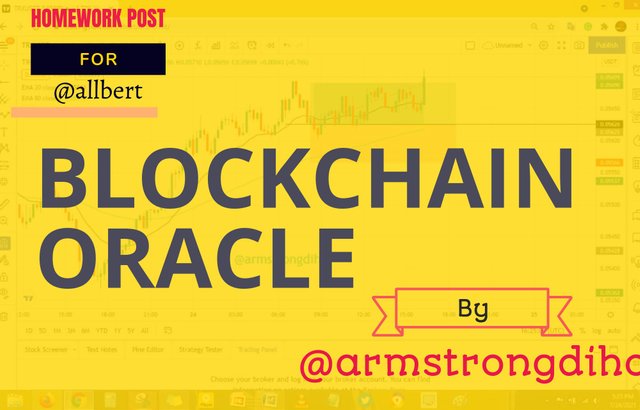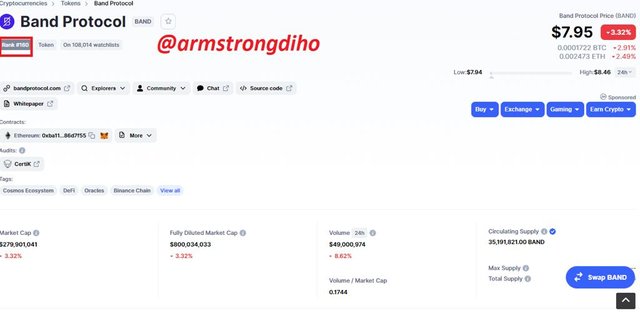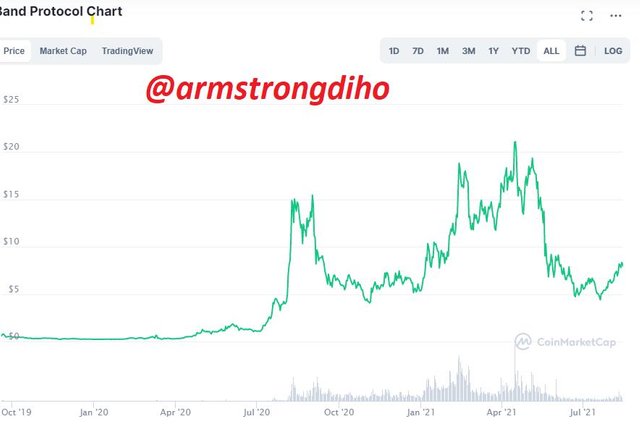
Introduction
For every business to survive, it must follow through the chain of distribution of goods and services. Manufacturers and producers of goods depend on the middle to deliver these manufactured goods to the hands of the final consumers. Without the final consumer most goods would not have made the success they enjoy in the market today.
In the world of blockchains smart contracts are designed to access external information from blockchain oracles, which are third-party services. Between blockchains and the outside world, they act as a link between the two.
Furthermore, a blockchain oracle does not generate data, instead it is the layer that queries, verifies, and authenticates external data sources before relaying it. Information transmitted by oracles can take many forms, including price information, confirmation of a payment, and temperature information.
Band Protocol (Question1)
It is a decentralized cross-chain data oracle platform that combines merges real-world data, APIs, and smart contracts in real time. On BandChain, an independent Proof-of-Stake (DPoS) blockchain built with the Cosmos SDK, this protocol is implemented. A custom-built oracle computation platform, BandChain was built to handle settlement, data sourcing, and aggregation. In exchange for staked BAND, validators get commission fees generated by the protocol. This project was developed in 2017 by Paul Chonpimai, Sorawit Suriyakarn, and Soravis Srinawakoon.
Band protocol was was developed to help eliminate the problems associated with smart contract applications when accessing data from the real world. Aside from that, it was designed to be a medium for authentic transaction speed and scalability. Data flexibility, cross-chain compatibility (blockchain-independent), and the ability to serve a large volume of data requests to multiple public blockchain networks with minimal latency (ability to support both public and private data).
The Band Protocol is a cross-chain protocol that works with Ethereum and other blockchains. The Cosmos Network uses the Band protocol. When creating the Cosmos network, the goal is for there to be many blockchain nodes that are connected together. With the Cosmos SDK, Tendermint's Byzantine Fault Tolerant (BFT) consensus mechanism, and the Cosmos Inter-Blockchain Communication Protocol, the Band Protocol connects to other blockchains and is built on top of it (IBC).
Network participants who own BAND tokens are responsible for verifying data through consensus when using the Band Protocol. Nodes that verify the real-world data sent to various blockchains use BAND, the protocol's native token, as collateral for transactions. Validators and delegators are two types of nodes. Blockchains based on Cosmos' DPoS (Delegated Proof-of-Stake) protocol typically have a two-node structure.
After a successful transition to Band Protocol v2.0 (also known as BandChain) from the community token and bonding curve model in v1.0, Band Protocol experienced a rapid growth spurt in 2020. Due to Band Protocol's new direction, there are more than 50 Oracle Integration projects in the works, as well as 15 new genesis validators for Band Protocol version 2.0.
After joining the OpenAPI Initiative in December 2020, Band Protocol will be the first blockchain company to join the ranks of the likes of Google, Microsoft, or IBM. A common API standard will be created by this group, allowing blockchain applications to easily access APIs and data.
Band tokens Associated
When validators produce new blocks, take part in consensus, and respond to data requests, they are rewarded with the native BAND token. BAND is unique in that it has both an Ethereum-based ERC-20 token iteration and a newer Band Protocol mainnet form. In a 1:1 ratio, the two coins are interchangeable, but only the newer mainnet coin can be staked.
BAND uses an inflationary supply model to encourage users to stake their BAND coins on the network instead of simply holding or trading them. By participating in network activities and earning BAND rewards, one's own BAND holdings will grow as a result of the inflationary supply.
However, It is estimated that BAND's annual inflation rate fluctuates between 7 and 20 percent, with regular adjustments in order to keep 66 percent of the total coin supply staked. The BAND is ranked at no.160 on the coin market chart, and the price stood at $7.95 as the time of writing this and a market capitalization of $279, 901,041, fully diluted market cap was $800, 034, 033 while the volume/market stood at 0.1744.


Functionalities and real-life applications.(Question 2)
BAND protocols primarily functions by providing real world data to decentralized systems. This is basically done by provision of transparent data financial reward system of giving out BAND tokens.
BAND protocols are designed to automate the execution of transactions, smart contracts and are also used in a variety of DeFi protocols. Those contracts that rely on real-world data are unable to carry out any transactions. As a result, projects such as Band Protocol can make a difference.
Through APIs, smart contracts receive data from the outside world, which Band Protocol then aggregates and makes available to users. I find it fascinating that the blockchain oracles of Band Protocol serve two purposes. Additionally, the blockchain oracles of Band Protocol are also used in block validation as well as data transfer.
Band Protocol is the first blockchain company to join the ranks of the likes of Google, Microsoft, or IBM. A common API standard will be created by this group, and this will serve as a medium for blockchain applications to easily access APIs and data.
Pros (Question 3)
Easy to use: the user interface is designed in a way that users do not have to go through a rigorous process before getting access to needed data. Decentralized applications can be integrated with band protocol without major changes.
Affordability: Band protocols are way cheaper because it consumes at least half the amount of gas compared to other decentralized competitors
Speed: Band was designed to run almost at the speed of light. Data can be processed within a single transaction and it does not need a confirmation from the blockchain because the needed data already exist on the platform.
Scalability: Operator costs are the same for data providers, no matter how many decentralized applications are utilizing them. Once an item is implemented on-chain, data can be consumed by multiple smart contracts at no extra cost to data providers.
Cons
Misinformation: When a data source is overly dependable, it can lead to a variety of problems. If the owner of an oracle feed posts inaccurate data, they may be able to influence smart contracts.
Hack: As an alternative, someone could hack the data feed in order to sway the data to their advantage. Criminal mind elements can take advantage of loophole or lacuna in the system to carry their dubious activity.
Inconsistency: The Band team has not produced any original academic research, and it lacks experience in building distributed systems and oracles, especially ones that secure real value in production, which is a major problem. Over the course of their development, they have abandoned their original design and changed their protocol a variety of times.
Future developments and new projects(Question 4)
Decentralization is growing rapidly and estimates shows that within a year the sum of $40 billion was the total value locked.
Market size of $26.5 trillion is expected by 2022, and DeFi has barely scratched the surface of the traditional financial market. However, there is much work to be done in making this project a success.
Defi's quest to reach a trillion-dollar market will require the help of decentralized oracle providers like Band Protocol. Developers will be able to put Band Protocol oracles in a fully documented, self-serviced manner by the end of 2021. With the conclusion of phase one in the previous year, band protocol is set to monetize their operations from 2021.
Conclusion
By 2022, the traditional financial market will be valued at $26.5 trillion. DeFi has only just begun to tap into its full potential. There's a long way to go. Decentralized oracle providers such as Band Protocol will play a crucial role in DeFi's quest to reach a market size of $1 trillion or more.
THANKS FOR READING THROUGH
cc
@allbert